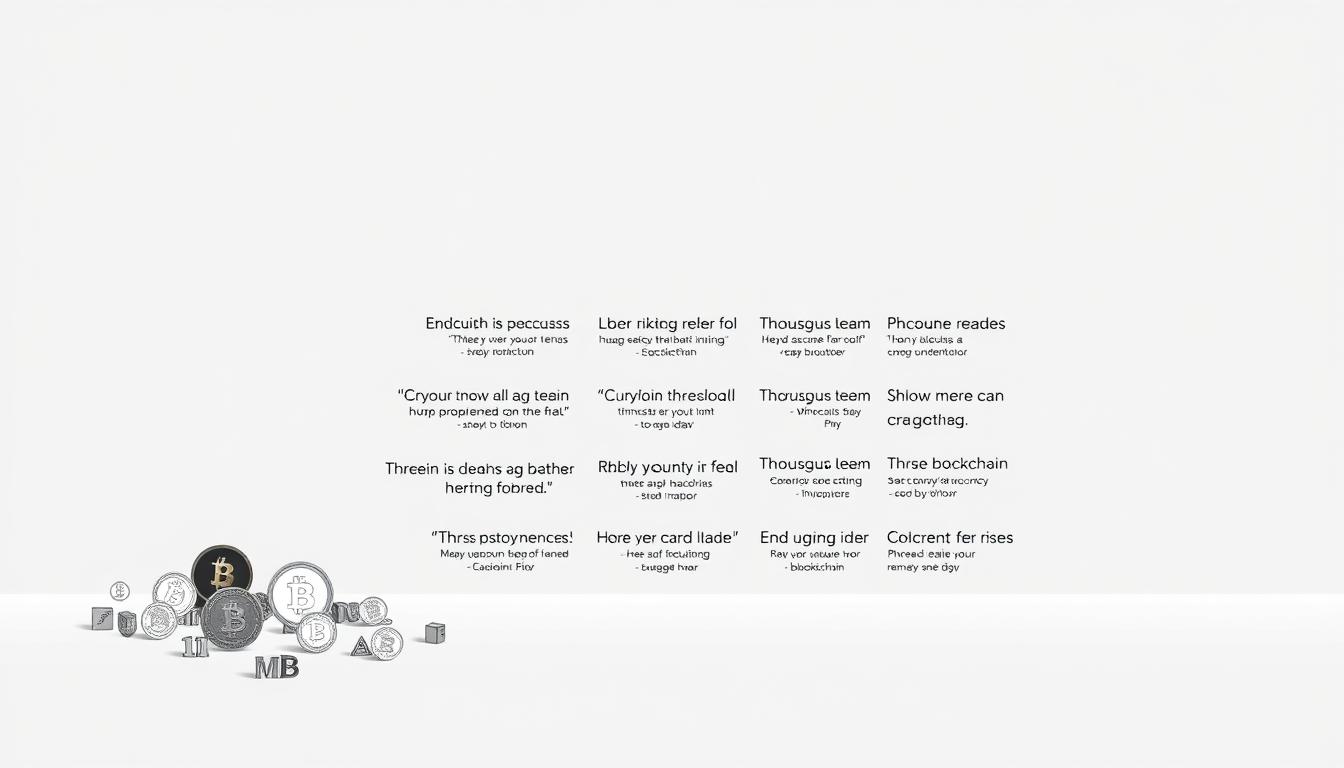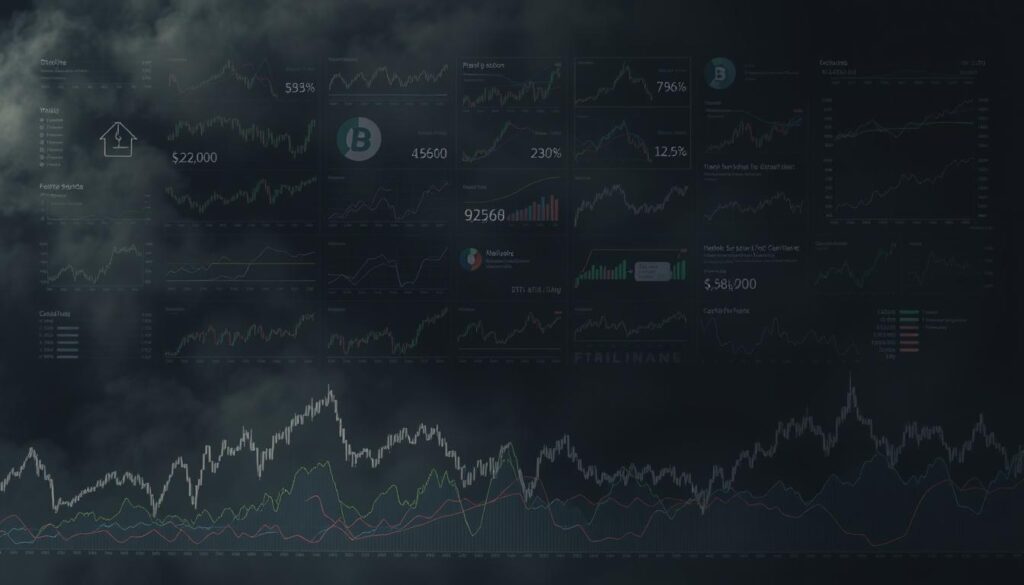Now Reading: Essential Crypto Quotes: Insights to Inform Your Investments
- 01
Essential Crypto Quotes: Insights to Inform Your Investments
Essential Crypto Quotes: Insights to Inform Your Investments

Crypto quotes and insights from industry leaders can turn uncertainty into clarity in the volatile cryptocurrency market. Seasoned traders and newcomers alike rely on expert analysis to spot trends and make informed crypto investment tips. Reliable perspectives help navigate price swings and market shifts.
Key Takeaways
- Expert crypto quotes provide actionable guidance for investment decisions.
- Crypto investment tips rooted in data-driven insights reduce risk exposure.
- Market trends revealed through insights help investors avoid common pitfalls.
- Combining expert commentary with personal research builds a stronger strategy.
Understanding the Value of Expert Crypto Quotes and Insights
Expert opinions guide us through the unpredictable crypto market. Unlike other markets, crypto prices change fast, reflecting what people think in real time. Analysts and researchers use data to give crypto quotes and insights, helping investors make smart choices.
They uncover trends in blockchain data and market actions, making sense of the unknown. For instance, during Bitcoin’s 2020 halving, experts forecasted price changes based on supply. This shows how cryptocurrency analysis helps guide investment decisions.
Why Expert Opinions Matter in Cryptocurrency Markets
Experts give meaning to numbers. Take the 2021 Ethereum price jump. Data showed higher transaction fees, but analysts pointed to ETH’s move to proof-of-stake as the main reason. Their credibility comes from past accuracy, like CZ (Binance CEO) or PlanB (Stock-to-Flow model).
How Insights Differ from Raw Data
- Data: Transaction volumes, hash rates, or on-chain metrics
- Insights: Analysts explain why these figures matter—like linking rising NFT sales to Ethereum’s network growth
Without analysis, data is just numbers. Crypto quotes and insights turn these into stories. For example, Grayscale’s reports highlight Bitcoin’s growing acceptance by institutions.
The Impact of Thought Leaders on Market Sentiment
Elon Musk’s 2021 tweet about Tesla’s Bitcoin investment or MicroStrategy’s Bitcoin purchases show how statements can affect prices. Sentiment shifts with major figures’ words or interviews. Analysts like Pseudonymized researcher “Hasu” often start new trends with in-depth reports, showing the influence of informed opinions.
Identifying Reliable Sources for Cryptocurrency Analysis
Cryptocurrency analysis needs careful thought. With so many sources, finding the right ones is key. Look for sources with a solid track record. Sites like Coindesk or CoinMarketCap are known for their clear methods and research.
- Verify expertise: Find analysts with experience in blockchain or finance.
- Check transparency: Good sources show where they get their data and any conflicts.
- Assess consistency: See if their long-term predictions match the market.
Watch out for sudden “exclusive insights” or promotions. Fidelity’s guidelines suggest checking claims on other sites. Stay away from places that spread rumors or ignore past performance.
Good cryptocurrency analysis combines market updates with technical details. Look for sites that publish white papers and audits. Mix traditional finance analysis with developer talks to uncover hidden gems or dangers.
Be wary of sources that make money off hype. Use verified data, developer activity, and regulatory news to make smart choices. Always check if the information matches real market data, not just stories.
Decoding Technical Predictions from Blockchain Innovators
Blockchain developers and engineers often share forward-looking statements about upcoming changes. To grasp their vision, start by evaluating development roadmaps. Publicly published timelines and protocol upgrades reveal priorities. For instance, Ethereum’s shift to proof-of-stake included clear milestones tracked by investors.

Interpreting Developer Forecasts
Assess technical roadmaps for clarity on deadlines. Compare past project delivery dates with current claims. A team that consistently meets deadlines builds credibility for future blockchain technology insights. Tools like GitHub repositories show active code contributions, signaling project momentum.
Cracking Technical Terms
- Scalability: Increasing transaction capacity without centralization
- Sharding: Splitting networks into partitions to boost speed
- Consensus mechanisms: Rules validating transactions (e.g., proof-of-stake)
These terms directly impact digital currency trends. For example, Bitcoin’s Lightning Network upgrades aim to resolve scalability concerns.
Spotting Real Innovation
Look for working prototypes before valuing claims. Ask: Is there testnet data? Has the innovation been stress-tested? Red flags include vague timelines or overemphasis on token price. Focus on technical whitepapers and peer-reviewed research instead of social media buzz.
How to Apply Market Indicators Alongside Expert Commentary
Effective cryptocurrency analysis needs both data and expert views. Here’s how to use market signals and analyst insights for better crypto choices.
Combining On-Chain Analysis with Expert Insights
On-chain metrics show real-world use trends. Compare these with what analysts say about growth or slowdown. For instance, rising active addresses might back up bullish forecasts. But different data can show doubts.
- Active addresses: Track user engagement
- Transaction values: Gauge institutional or retail activity
- Network hash rate: Measure mining health
Using Trading Volume Context for Quote Interpretation
Trading volume shows if price moves match analyst views. High volume with price jumps confirms expert-driven trends. But low volume with big gains might hint at manipulation or weak basics.
Price Action Validation of Expert Predictions
Test crypto price predictions against past results. See how often an analyst’s past calls matched price swings. Tools like TradingView or CoinMetrics show this alignment, pointing out reliable analysts.
For example, if an analyst said Bitcoin would rally after the 2023 halving, check the price charts after. Did the market follow their forecast?
Leveraging Social Media for Real-Time Crypto Insights
Social media sites like Twitter, Reddit, Telegram, and Discord are key for crypto news. Twitter is home to big names like Michael Saylor and Cathie Wood. Their tweets can change the market. Reddit and Discord have groups for deep crypto talks.
Follow developers, teams, and analysts to get the latest. Use Twitter Lists for topics like DeFi or NFTs. On Reddit and Telegram, save searches and channels to cut through the noise. Set up price alerts with apps like TwitSpark or Discord bots.
- Verify sources: Check claims against official websites
- Watch interaction patterns: Real engagement without bots is a sign of trustworthiness
- Track sentiment shifts: Changes in chat can signal market moves
Be careful of fake pump-and-dump schemes. Look for real messages from verified accounts. Ask if it matches blockchain data and if the author is reliable. Social media is great for spotting trends early, before they hit big news sites.
The Historical Context: Learning from Past Crypto Predictions
Looking back at crypto price predictions teaches us a lot. Even the best experts can’t always get it right in these fast-changing markets. By studying past wins and losses, we can make better choices today.

Case Studies of Accurate Crypto Forecasts
Some predictions have really hit the mark. In 2017, PlanB’s Stock-to-Flow model predicted Bitcoin’s 2020 price range with accuracy. Crypto Twitter’s Rekt also spotted the 2021 DeFi boom by analyzing on-chain data. These examples show the power of using technical and behavioral analysis together.
Famous Misses in Cryptocurrency Predictions
- JPMorgan’s 2018 “crypto is dead”
- Gold bugs dismissing Bitcoin’s 2020 rally
- Overestimating CBDC adoption timelines
These mistakes came from not seeing the pace of innovation or overvaluing old ways.
Pattern Recognition in Expert Commentary
Bull markets often bring too-optimistic predictions, while bear markets highlight regulatory risks. Common themes include:
- Halving cycles driving Bitcoin price speculation
- Media hype cycles amplifying FOMO
- Institutional adoption timelines shifting
By recognizing these patterns, we can tell real insights from just noise. History teaches us that no single method lasts forever. Being able to adapt is crucial.
Creating Your Own Framework for Evaluating Digital Currency Trends
Starting to analyze digital currency trends means setting clear goals. Think about how much risk you can take, your time frame, and what you want to achieve. This helps you make smart choices, not quick ones based on rumors.
- Criteria Checklist: Rank projects by utility, team credibility, and adoption metrics.
- Data Layers: Combine on-chain metrics with social media sentiment tools like CryptoTwitter or CoinDesk’s analysis.
- Review Cycles
Check how things are going every week or month. Use tools like TradingView for charts and CoinMarketCap for market size.
Good crypto investment tips are about being steady. Write down why you made each choice. Look back at these notes when the market changes. For instance, Bitcoin’s 2020 halving showed the value of holding onto it long-term.
Check your framework often with past data. Sites like Glassnode give free tools to check your ideas. Be careful of too-rosy predictions by looking at real data and expert views.
Blockchain Technology Insights: Separating Innovation from Speculation
When looking at blockchain advancements, it’s key to tell real changes from hype. Start by focusing on blockchain technology insights that talk about major updates. For example, Ethereum’s move to proof-of-stake cut down energy use and costs, making ETH more useful. On the other hand, small changes that get a lot of attention but don’t really help in real life.
Protocol Upgrades and Their Investment Implications
Look at upgrades through three main points: can it be done, will developers use it, and will the market adopt it? Bitcoin’s Taproot update made smart contracts better without changing the main rules, which helped its value. Compare this to projects that promise a lot but don’t actually do anything. Watch how active the community is and how clear the project’s plans are to see if it’s real.
Scalability Solutions and Market Impact
Layer-2 networks like Polygon and Optimism help lower fees but need more people using the base layer token. Ethereum’s sharding aims to handle over 100k transactions per second. Keep an eye on blockchain market updates for progress signs. Look at how much the network is growing and who’s working with it to see if it’s really working.
Regulatory Developments Through Expert Lens
Changes in rules, like the SEC’s DeFi crackdown, can really affect token prices. Keep up with what firms like Chainalysis or CoinDesk say about these rules. Projects that are open about their legal plans, like Solana’s recent SEC filing, usually do better than those facing legal issues. Use expert opinions to understand how laws affect tech progress.
Virtual Asset News Analysis: Reading Between the Lines
Keeping up with virtual asset news is more than just reading headlines. Analysts need to understand how updates in the blockchain market affect investors. Start by looking into where the news comes from. Specialized forums often share updates before big news sites, giving early clues.
- Source Verification: Compare reports from technical platforms like Etherscan with speculative pieces on social media.
- Contextual Clues: Note if a blockchain market update focuses on protocol adoption rather than price speculation.
- Timing Analysis: Track when exchanges like Binance announce integrations before wider media coverage.
Look for common themes in virtual asset news. A sudden increase in DeFi partnership announcements might signal a big change. Use tools like Google Trends to see how search interest matches news cycles. For example, when regulatory updates appear on CoinDesk, check price reactions on TradingView charts within 24 hours.
Make a checklist: Does the report use on-chain data or just opinions? Are experts from different places quoted? This helps sort out the important news. Remember, the first big blockchain market update on specialized sites usually comes 48 hours before it hits the mainstream, giving traders a head start.
Translating Expert Insights into Practical Investment Decisions
Expert crypto quotes and insights are key for smart investment tips. But, turning them into action needs a clear plan. Start by seeing how analysts’ views match your investment goals.
Portfolio allocation starts with following expert advice. For example, if 70% of analysts say Ethereum’s Layer 2 upgrades are promising, put some money into ETH. Also, spread your money into altcoins with different trends. Use scoring systems to pick quotes from the most accurate analysts.
- Consensus tracking: Watch how crypto quotes and insights change on sites like CoinDesk or CryptoSlate.
- Position sizing: Put 5-10% of your money into big bets, and keep 70% in stable assets.
Risk management turns theory into action. Experienced investors use stop-loss triggers based on technical analysts’ advice. For example, if a bearish quote says Bitcoin might drop to $20k, set stops below that. Also, watch correlation matrices to avoid too much risk in similar assets.
Market timing uses expert sentiment extremes as signals. When everyone is bullish (like “Bitcoin to $100k by Q4”), think about reducing your investments. But, when everyone is pessimistic, use dips to buy strong projects.
Common Pitfalls When Following Crypto Price Predictions
Crypto price predictions can be tempting, but jumping in without thinking can cost you. Many investors don’t consider the context of these forecasts. They might fall into traps like confirmation bias, where they only look at data that supports their views. Others might see short-term trends as long-term signs, missing how predictions can change with market shifts.
- Overvaluing precision: Exact price targets (e.g., “BTC will hit $100K by Q3”) rarely account for external factors like regulatory shifts.
- Narrative cascades: Repeated quotes gain traction even without data backing, inflating hype around cryptocurrency analysis trends.
- Ignoring incentives: Analysts may promote bullish views to drive trading volume, not reflect honest cryptocurrency analysis.
In 2021, many crypto price predictions said “$100K BTC by end-2021” without mentioning China’s mining crackdowns. This led to overestimates. Look out for vague timelines, missing risk factors, and single-source data. Always check forecasts against on-chain metrics and market basics to avoid biased choices.
Be wary of overly confident claims. Good investors focus on cryptocurrency analysis that explains why a prediction is made, not just the result. Be aware of how personal biases and outside pressures shape crypto price prediction stories.
Building Your Personal Network of Trusted Crypto Information Sources
Staying up-to-date in crypto needs a mix of free and paid sources. A diverse network gives you better access to analysis and tips. Here’s how to create your essential list:

Communities for Ongoing Education
Join forums like BitcoinTalk and Reddit’s r/CryptoCurrency for discussions. Discord servers, like Crypto Research Lab, offer live debates on updates. Also, attend local blockchain meetups or subscribe to CoinDesk newsletters for structured learning.
Subscription Services Worth Considering
Paid platforms like The Block Research offer detailed reports. For updates, Coinbound is great for official news. Premium tools like Santiment combine data with analytics, helping with decisions.
Free Resources That Provide Quality Insights
YouTube channels like CryptoTV have beginner tutorials. Podcasts, like “The Flippening,” explain market trends. Free tools like CoinMetrics offer open-source data. SEC filings and FOMC minutes give regulatory insights without cost.
Becoming Your Own Crypto Analyst: From Consumer to Creator of Insights
To master crypto analysis, you need to do more than just read crypto quotes and insights. Start by following daily blockchain market updates. Look for trends in prices, trading volumes, and updates to protocols. Use tools like Etherscan or Glassnode to check if expert claims match real data.
Keep a journal for your investment ideas. Write down your predictions based on crypto quotes and insights. Then, see how they match up with what really happens in the market. This helps you learn to spot patterns on your own.
Share your early analysis on Twitter or crypto forums. Feedback from others can help you see where you’re wrong and what you missed. Joining groups like CoinDesk’s Insights or Chainalysis reports helps you stay up-to-date with blockchain market updates.
Getting good at analysis means you can make your own decisions. Keep practicing with real data. This way, your choices are based on what you know, not just what others say. Becoming an analyst lets you dive deeper into every crypto quote, not just accept it at face value. This journey prepares you to make smart choices in a fast-changing market.
FAQ
What are crypto quotes and insights?
Crypto quotes and insights are expert opinions on cryptocurrency trends and prices. They help investors understand market movements and sentiment. This knowledge is crucial for making smart investment choices in the crypto market.
Why should I rely on expert insights for crypto investment?
Expert insights offer more than just numbers. They guide investors through complex markets. By following industry leaders, investors can see the bigger picture of crypto trends and dynamics.
How can I evaluate the reliability of cryptocurrency analysis sources?
Look at the source’s track record and how transparent they are. Check for any conflicts of interest and the analysts’ expertise. Reputable media and crypto publications usually offer reliable insights.
What should I know about technical predictions from blockchain innovators?
Technical predictions use industry terms and talk about updates. Knowing about “scalability” and “smart contracts” helps understand their market impact.
How can I combine market data with expert commentary?
Mix on-chain metrics with expert opinions for a full view of the market. Analyzing trading volumes with expert views helps assess the reliability of these opinions.
What are effective ways to use social media for crypto insights?
Twitter and Reddit are great for real-time crypto news. Follow credible voices and join relevant groups. Use alerts for breaking news and expert opinions.
How can past crypto predictions help me make better investment decisions?
Learning from past predictions teaches about market psychology. Studying accurate forecasts and misses helps improve future decision-making.
What should my framework for evaluating digital currency trends include?
Your framework should cover fundamental, technical, and sentiment analyses. It should match your investment goals and risk tolerance. This approach helps make informed decisions.
How do regulatory developments impact blockchain investments?
New regulations can greatly affect blockchain projects. Expert opinions on these changes help investors understand their market impact.
What common mistakes do investors make when acting on price predictions?
Investors often fall into psychological traps, misjudge timeframes, and rely on precise predictions without context. Being critical and skeptical helps avoid these mistakes.
How can I build my personal network of trusted crypto information sources?
Engage with educational communities, evaluate subscription services, and use free quality resources. This builds a network of trusted sources.
How can I transition from being a passive consumer of crypto information into an active analyst?
Start documenting your market observations and testing hypotheses. Keeping an investment journal helps learn and think critically. Share your analyses to refine your insights through feedback.













